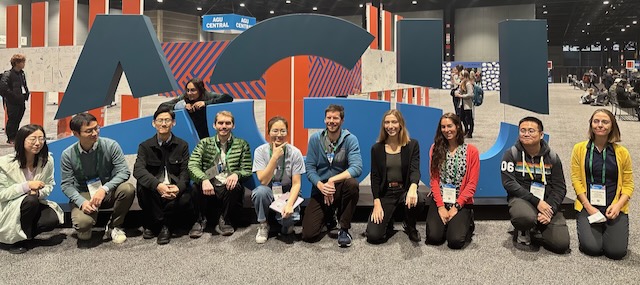We’ve just submitted our Q4 report (Oct to Dec 2022) to our funders. Here’s a quick round-up of our progress…
Science Progress
- Demonstrated strong thermal acclimation of sapwood respiration, twice as large as the thermal acclimation of leaf respiration which is consistent with our optimality-based theoretical predictions. Thermal acclimation of respiration is currently missing from most LSMs; implementing this will decrease the modelled global climate-carbon feedback.
- Used global eddy covariance observations to quantify the critical soil moisture threshold (θcrit) and evaporative fraction (EF) regimes and found systematic differences in quantities defining the EF-SM relationship across biomes. This research suggests an optimal adaptation of the EF-SM response that maximises growing-season evapotranspiration and photosynthesis.
- Found with our empirical analysis of LUE, LUE is controlled by daytime temperature, vapour pressure deficit, the diffuse fraction of solar radiation, and soil moisture. There was wide variation in the shape, strength, and sign of the environmental effects on simulated LUE.
- Developed an objective formulation for partitioning water loss from the soil (evaporation) and from vegetation (transpiration) using a two-source model to estimate the ratio of transpiration (T) to evapotranspiration (ET) at the catchment scale. We have used this model to produce estimates of T:ET for all FLUXNET sites and AmeriFlux datasets and analysed the dependencies of T/ET on LAI and hydrological and environmental conditions.
- Demonstrated that canopy interception or the evaporative loss of interception (Ei) has declined by 4.9% globally since 2000. This is due to a reduction in frequency but the increased intensity of rain events. Since increased soil moisture may benefit ecosystem functioning, it would be useful to assess the impact of this decline in a modelling context.
- Conducted growth chamber experiments for a fully factorial manipulation of CO2, soil nitrogen, and capacity for biological nitrogen fixation (BNF) to evaluate plant C-N interactions in soybeans. We found a downregulation of Vcmax25 in response to elevated CO2 regardless of the soil N or inoculation status. We found a strong positive effect of soil N fertilisation on Vcmax25 in non-inoculated pots, but no effect of soil N in pots with BNF treatment.
- Investigated the acclimation of photosynthetic biochemistry to light Our results show that shading reduces plant investment in photosynthetic biochemistry in line with predictions based on optimality theory.
- Examined the role of soil N in driving the acclimation of photosynthesis and plant growth and confirm that the addition of nutrients leads to the strong stimulation of whole plant aboveground biomass and productivity in fertilisation experiments, while the effects on leaf-level traits and photosynthetic capacities are weak.
- Developed an Illustrative model for simulating C and N allocation based on the P-model, for an optimal acclimation of leaf-level quantities, that predicts the responses seen in CO2 and N-fertilisation experiments for multiple variables simultaneously. The separation of the two axes of responses in the model – acclimation and allocation – provides a basis for a more realistic approach to modelling coupled C and N dynamics in terrestrial ecosystems.
- In our framework of the VIC+ model, initial results show that root dynamics play an important role in promoting transpiration under water-limited conditions with the effects greater in drier conditions or deeper groundwater tables. The new scheme will be beneficial to model the interactions between subsurface processes and plant transpiration and photosynthesis.
- Demonstrated that fire return time is a strong control on the abundance of resprouting plants across multiple ecosystems. This work provides a quantitative basis for incorporating plant responses to fire in an optimality-based model framework.
Conferences

Many LEMONTREE team members took part in AGU in December 2022 in Chicago. With the team involved in 22 presentations/. We chaired 5 sessions, gave 11 oral presentations and 3 poster presentations. It was great to have so many members of the PI team, post-docs and PhD students there to present out work. You can read more about this in our AGU blog: https://research.reading.ac.uk/lemontree/lemontree-at-agu/
Hello/ Goodbyes
We have welcomed to our team Wenyao Gan who starts her PhD at the University of Reading with Sandy Harrison and Dr Jaideep Joshi at the University of Bern with Beni Stocker. We say goodbye to Julia Green from Berkeley but welcome Maoya Bassiouni to the team there. At Tsinghua University, our new joiners are Dr Jian Zhou, Lewei Jin and Zeu Feng and congratulations to Shengchao Qiao who has completed his PhD, we hope to continue collaborating.
Recent publications
(LEMONTREE team in bold)
- Fu, Z., Ciais, P., Feldman, A.F., Gentine, P., Makowski, D., Prentice, I. C., Stoy, P.C., Bastos, A., Wigneron, J-P. 2022. Critical soil moisture thresholds of plant water stress in terrestrial ecosystems. Science Advances, 8(44) https://www.science.org/doi/10.1126/sciadv.abq7827
- Jeong, S., Ryu, Y. Dechant, B., Li, X., Kong, J., Choi, W., Kang, M., Yeom, J., Lim, J, Jang, K., Chun, J. 2023. Tracking diurnal to seasonal variations of gross primary productivity using a geostationary satellite, GK-2A advanced meteorological imager. Remote Sensing of Environment, 284, https://doi.org/10.1016/j.rse.2022.113365
- Bloomfield, K. J., Keenan, T.F., Stocker, B.D., Prentice, I.C. 2022. Environmental controls on the light use efficiency of terrestrial gross primary production. Global Change Biology. https://doi.org/10.1111/gcb.16511
- Lian, X., Zhao, W., Gentine, P. 2022. Recent global decline in rainfall interception loss due to altered rainfall regimes. Nature Communications, 13 (7642), https://www.nature.com/articles/s41467-022-35414-y
- Green, J., Ballantyne, A., Abramoff, R., Gentine, P., Makowski, D., Ciais, P. 2022. Surface temperatures reveal the patterns of vegetation water stress and their environmental drivers across the tropical Americas. Global Change Biology. https://onlinelibrary.wiley.com/doi/pdf/10.1111/gcb.16139
- Wang, H, Prentice, I.C., Wright I. J. Qiao, S., Xu, X., Kikuzawa, K., Stenseth, N.C., 2023. Leaf economics is explained by optimality principles. Science Advances 9, https://www.science.org/doi/10.1126/sciadv.add5667
- Qiao, S., Harrison, S.P., Prentice, I.C., Wang, H., 2023. Optimality-based modelling of wheat sowing dates globally. Agricultural Systems 206: 103608, https://doi.org/10.1016/j.agsy.2023.103608

